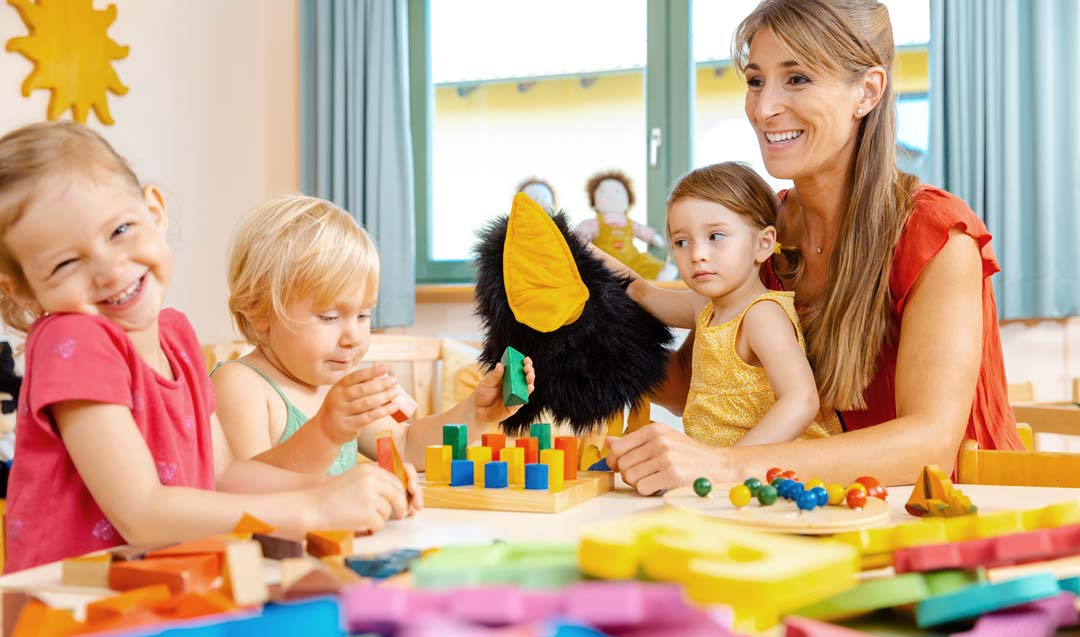INTERACTIONS WITH YOUNG CHILDREN IN AN EDUCATION AND CARE SETTING
For relationships to be meaningful, interactions need to be warm, caring, and responsive. If we focus on building connections and maintaining them, children are more likely to feel a sense of security, well-being and belonging.

Each day we undertake meaningful and intentional interactions with children, and some are incidental and pleasurable as we converse with children about the many things of interest or importance to them in that moment.
As adults, do we all make the most of those moments and are our intentional interactions thoughtful and supportive of children? What should we know about this and how can our interactions more effectively support them?
We need to consider how we communicate. This involves three main types of communication in education and care settings.
- Verbal. This is through spoken words using tone and pitch, volume, face to face conversations, in a one to one or group situation.
- Non-verbal. We use body language, facial expressions, gestures, physical appearance, and distance at different times.
- Use of images. We may also use images, signs, objects, technology, and symbols to indicate our message.
As we use any of the above methods, we should be aware of the effect it will have on the recipient of the information we are sharing. What kind of environment are we creating for the children and our colleagues when we communicate? Are we in the habit of . . .?
- Interrupting children
- Speaking over them when they are trying to tell us something important to them
- Assuming we know what they are going to say before we let them finish
- Expecting them to wait while we talk first
These are disrespectful habits many adults employ without realising it and just out of habit. Continual use of these discourages children from trying to be effective communicators and prevents them trying to share their ideas. It hinders their language, cognitive development, and creative growth.
I suspect we are all guilty of these on occasion. We need to reflect on our own habits when interacting with children and identify where we can improve our technique. We should continually work towards meaningful and respectful communication with children and each other.
A good rule of thumb is that children require up to 8 seconds to respond when adults speak to them or ask a question. Consider that children are gathering their thoughts to respond, considering what they wish to say, working out the words to use in their response, then giving a response. They have a lot to process when conversing with us and those 8 seconds become very important if we are to engage in positive, respectful, extended, and meaningful discussions with children.
What are the benefits for us if we manage to do this? The use of positive communication with educators, children and families creates an environment where individuals feel valued and respected. Positive communication has many benefits for children and educators, including the following:
- creating a sense of belonging
- feeling included and valued
- developing trust
- fostering self-esteem
- promoting open, honest communication
- feeling comfortable to express ideas and opinions
- modelLing positive communication styles
- sharing ideas
- providing support
- providing a consistent approach to care
- providing clear expectations and guidelines for behaviour
- determining roles and responsibilities
- supporting positive resolution of conflict
- creating a harmonious play and work environment
By interacting positively and meaningfully with children, educators help children to feel accepted and develop a sense of attachment and trust. Children who are supported to understand themselves experience a sense of belonging that fosters self-esteem.
A positive side benefit is that positive behaviour is more likely to be the ‘norm’, not the anomaly. This means a less stressful day for children, families, and educators.
We know that from research across the globe that some basic elements must be present for young children to thrive.
- Security of trusted adults and the strong connections made with them.
- Soothing, welcoming environments and daily routines they can comfortably anticipate – no big surprises to fear or be anxious about.
- Familiar, trusting, and respectful relationships with adults and carers around them – consistency and continuity of care is key.
- Positive communications that support all in the education and care setting, with particularly positive outcomes for children.
Positive, caring, and meaningful interactions form the basis of these relationships and must be a priority for all adults and educators every day.
CONTACT ONE OF OUR CENTRES
Out & About Care and Education
2 Newspaper Place
Maroochydore Q 4558
newspaperpl@outandabout.net.au
07 5413 8099
CONTACT NEWSPAPER PL
Out & About Care and Education
30 Dalton Drive
Maroochydore Q 4558
daltondr@outandabout.net.au
07 5479 1411
CONTACT DALTON DR
Out & About Care and Education
6 Mooloolah Rd
Mooloolah Valley Q 4553
mooloolah@outandabout.net.au
07 5356 9323

